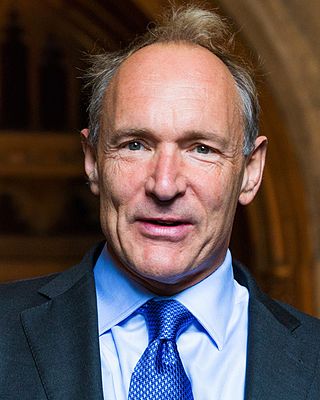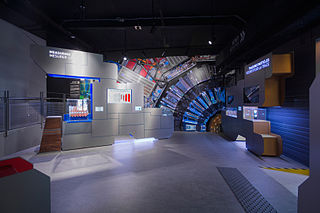
Ben Maurice Segal (born 19 May 1937 in Tel Aviv) is a British-Swiss computer scientist. He is known for his role as an Internet promoter. [1] [2]

Ben Maurice Segal (born 19 May 1937 in Tel Aviv) is a British-Swiss computer scientist. He is known for his role as an Internet promoter. [1] [2]
He attended William Hulme's Grammar School, Manchester, and then Imperial College, London, graduating with a Bachelor of Science in physics and mathematics in 1958. [3]
Segal worked from 1958 to 1962 for the UK Atomic Energy Authority, Industrial Division, in Risley, on fast breeder reactor development. [4] He then moved to Detroit, Michigan, USA, to work on the Enrico Fermi fast breeder project from 1962 to 1965, [5] and then to Stanford University in California for a PhD in mechanical and nuclear engineering (1966–1971). His thesis was on “Shock wave structure using nonlinear model Boltzmann equations” under the supervision of Joel H. Ferziger. [6] [7]
In July 1971 he returned to Europe and worked as a systems programmer and later as a computer networking specialist at CERN—the European Organization for Nuclear Research in Geneva, Switzerland. Apart from a sabbatical year in 1977 working at the Bell Northern Research laboratory in Palo Alto, California, he stayed at CERN until his retirement in 2002.
Between 1985 and 1988 he co-ordinated the introduction at CERN of the TCP/IP Internet protocols, permitting interconnection of the principal computer systems inside the laboratory before CERN joined the world Internet in early 1989. [8] [9] [10] [11] [12] [13]
From 1989 he played a major role in the project “SHIFT” that replaced CERN's mainframe computers by distributed Unix clusters. [14] [15] [16] Segal was responsible for the system's high performance computer network. By the year 2000, SHIFT had already increased CERN's installed computing power by a factor of a hundred. The SHIFT architecture was then extended to build the World Wide LHC Computing Grid, [17] used since that time to analyse the massive and still increasing amounts of experimental data taken by the physics experiments around the Large Hadron Collider at CERN. In 2001 CERN was awarded the Computerworld Honors award for 21st Century Achievement for this innovative application of information technology to the benefit of society. [18] [19] [20]

Segal's work on TCP/IP and CERN's acceptance of the Internet in 1989, enabled Tim Berners-Lee to develop the World Wide Web and its related protocols. [22] [23] Berners-Lee acknowledged in 2014 Segal as a mentor during the years he developed the Web. [24]
Segal was a founding member of the Internet Society (ISOC), Geneva chapter, and elected to the ISOC Board of Trustees between 1997 and 2000. [25] [26]
Since his retirement, Segal remained active until 2023 as an honorary member of the CERN personnel. He has worked in the developing field of volunteer computing where the general public is invited to contribute to major scientific computing challenges by volunteering some of their private computing power. Segal co-founded and is still active in CERN's own such project, LHC@home, [27] [28] which has attracted several hundred thousand contributors since its launch in 2004. [29] [30] [31]

The history of the Internet has its origin in the efforts of scientists and engineers to build and interconnect computer networks. The Internet Protocol Suite, the set of rules used to communicate between networks and devices on the Internet, arose from research and development in the United States and involved international collaboration, particularly with researchers in the United Kingdom and France.

Sir Timothy John Berners-Lee, also known as TimBL, is an English computer scientist best known as the inventor of the World Wide Web, the HTML markup language, the URL system, and HTTP. He is a professorial research fellow at the University of Oxford and a professor emeritus at the Massachusetts Institute of Technology (MIT).

The European Organization for Nuclear Research, known as CERN, is an intergovernmental organization that operates the largest particle physics laboratory in the world. Established in 1954, it is based in Meyrin, western suburb of Geneva, on the France–Switzerland border. It comprises 23 member states. Israel, admitted in 2013, is the only non-European full member. CERN is an official United Nations General Assembly observer.
Network File System (NFS) is a distributed file system protocol originally developed by Sun Microsystems (Sun) in 1984, allowing a user on a client computer to access files over a computer network much like local storage is accessed. NFS, like many other protocols, builds on the Open Network Computing Remote Procedure Call system. NFS is an open IETF standard defined in a Request for Comments (RFC), allowing anyone to implement the protocol.

The Large Hadron Collider (LHC) is the world's largest and highest-energy particle collider. It was built by the European Organization for Nuclear Research (CERN) between 1998 and 2008 in collaboration with over 10,000 scientists and hundreds of universities and laboratories across more than 100 countries. It lies in a tunnel 27 kilometres (17 mi) in circumference and as deep as 175 metres (574 ft) beneath the France–Switzerland border near Geneva.

Robert Cailliau is a Belgian informatics engineer who proposed the first (pre-www) hypertext system for CERN in 1987 and collaborated with Tim Berners-Lee on the World Wide Web from before it got its name. He designed the historical logo of the WWW, organized the first International World Wide Web Conference at CERN in 1994 and helped transfer Web development from CERN to the global Web consortium in 1995. He is listed as co-author of How the Web Was Born by James Gillies, the first book-length account of the origins of the World Wide Web.

The Line Mode Browser is the second web browser ever created. The browser was the first demonstrated to be portable to several different operating systems. Operated from a simple command-line interface, it could be widely used on many computers and computer terminals throughout the Internet. The browser was developed starting in 1990, and then supported by the World Wide Web Consortium (W3C) as an example and test application for the libwww library.

LHC@home is a volunteer computing project researching particle physics that uses the Berkeley Open Infrastructure for Network Computing (BOINC) platform. The project's computing power is utilized by physicists at CERN in support of the Large Hadron Collider and other experimental particle accelerators.

Microcosm or CERN Museum was an interactive exhibition presenting the work of the CERN particle physics laboratory and its flagship accelerator the Large Hadron Collider (LHC). It first opened to the public in 1990 and closed permanently in September 2022, to be replaced by the Science Gateway in 2023. The final version of the exhibition opened in January 2016, developed by CERN in collaboration with Spanish design team Indissoluble.

Les Horribles Cernettes was an all-female parody pop group, self-labelled "the one and only High Energy Rock Band", which was founded by employees of CERN and performed at CERN and other HEP-related events. Their main claim to fame is that a photograph of them was one of the earliest photographic images shared on the world wide web.

The World Wide Web is a global information medium that users can access via computers connected to the Internet. The term is often mistakenly used as a synonym for the Internet, but the Web is a service that operates over the Internet, just as email and Usenet do. The history of the Internet and the history of hypertext date back significantly further than that of the World Wide Web.
EUnet was a very loose collaboration of individual European UNIX sites in the 1980s that evolved into the fully commercial entity EUnet International Ltd in 1996. It was sold to Qwest in 1998. EUnet played a decisive role in the adoption of TCP/IP in Europe beginning in 1988.

The Worldwide LHC Computing Grid (WLCG), formerly the LHC Computing Grid (LCG), is an international collaborative project that consists of a grid-based computer network infrastructure incorporating over 170 computing centers in 42 countries, as of 2017. It was designed by CERN to handle the prodigious volume of data produced by Large Hadron Collider (LHC) experiments.
Computational particle physics refers to the methods and computing tools developed in and used by particle physics research. Like computational chemistry or computational biology, it is, for particle physics both a specific branch and an interdisciplinary field relying on computer science, theoretical and experimental particle physics and mathematics. The main fields of computational particle physics are: lattice field theory, automatic calculation of particle interaction or decay and event generators.

The First International Conference on the World-Wide Web was the first-ever conference about the World Wide Web, and the first meeting of what became the International World Wide Web Conference. It was held on May 25 to 27, 1994 in Geneva, Switzerland. The conference had 380 participants, who were accepted out of 800 applicants. It has been referred to as the "Woodstock of the Web".

Guido Tonelli is an Italian particle physicist who was involved with the discovery of the Higgs boson at the Large Hadron Collider. He is a professor of General Physics at the University of Pisa (Italy) and a CERN visiting scientist.

François Flückiger is a French computer scientist who worked at CERN. He was selected for induction in 2013 in the Internet Hall of Fame.
The Protocol Wars were a long-running debate in computer science that occurred from the 1970s to the 1990s, when engineers, organizations and nations became polarized over the issue of which communication protocol would result in the best and most robust networks. This culminated in the Internet–OSI Standards War in the 1980s and early 1990s, which was ultimately "won" by the Internet protocol suite (TCP/IP) by the mid-1990s when it became the dominant protocol suite through rapid adoption of the Internet.